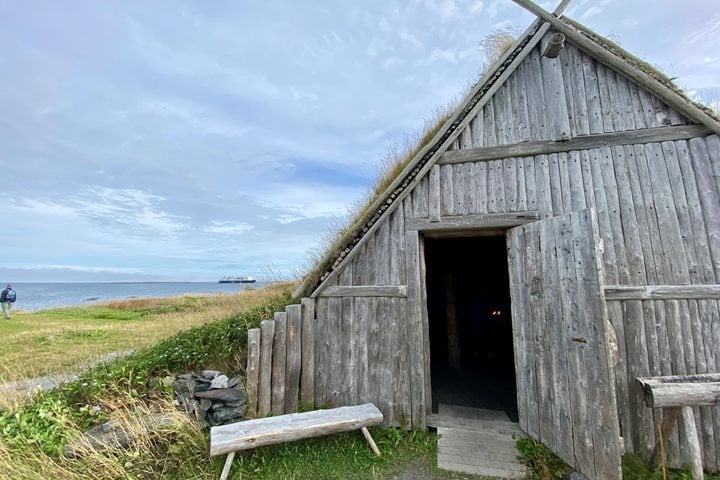This morning our explorations focused on the remarkable site of L’Anse Aux Meadows, the only authenticated Viking settlement site so far identified in North America. Following a short Zodiac run we boarded buses and drove to the modern interpretative centre which acts as an information gateway to this UNESCO World Heritage Site.
On display are a wide variety of artefacts recovered during the archaeological excavations which took place here in the 1960s and 1970s. The settlement, which was established by the first Europeans to reach the shores of North America, was discovered by the Norwegian explorer and writer Helge Ingstad, who after many years of study and searching, pinpointed the Viking base in 1960. On display is a bronze ring-headed pin, an iron ship nail and a stone spindle whorl, all of which are diagnostic Norse items. This is the westernmost site that can so far be attributed to the Vikings. A remarkably tenacious and adaptable people, they had established an extensive settlement and trading network between the 8th and 12th centuries which stretched from the Near East to what we now know as Newfoundland.
The site yielded the remains of nine sod-walled buildings which included longhouses, workshops, storage facilities and a forge. Bog iron ore is locally available and the inhabitants smelted this material and fashioned ships nails from the metal. This is the first recorded instance of ironworking in North America. This was not a settlement in the true sense of the word but rather a base for exploration and transhipment of materials, including timber and animal furs which would first have been stockpiled. Radiocarbon dates suggest that the site was only occupied for a relatively short period, around 1000-1020 AD, before being abandoned. The true reason for this is unclear.
The remains of the buildings consist of a series of low grassy mounds and ridges clustered on a low ridge close to the shore. Following a viewing of a short video in the visitor centre, which detailed the background to the discovery and subsequent excavation of the remains, we made our way down to the site itself. Here a series of low grassy banks and mounds are all that indicate the once substantial sod-walled homes and workshops of these stout-hearted entrepreneurs. A longhouse has been reconstructed and animators, attired in typical Viking clothing and equipment, explained the lifestyle of the erstwhile inhabitants.
We continued on to the nearby Viking village and trade port known as Norstead. This is a fascinating complex of reconstructed buildings, including a chieftain’s hall, church and blacksmith’s forge where on-site animators gave us a personal insight into the lifestyle, living conditions, crafts and trade of its Norse inhabitants. We then drove to St. Anthony where we had lunch.
The personage most famously associated with this coastal settlement is Dr. Wilfred Grenfell. Born in northern England in 1865, he devoted much of his life to alleviating the harsh working and living conditions of communities living in the remote areas of Newfoundland and Labrador. Fuelled by Christian conviction, he began a mission which established hospitals, an orphanage, schools and cooperatives. The town boasts the Grenfell Interpretive Centre which charts his life and work, and Grenfell House, the onetime home of this remarkable man which is now a museum, both of which were visited.
A rich array of flora was enjoyed by many who had taken part in a natural history hike through the boreal woodlands above the town. Shaded moss-bedecked dells, winding paths, the whispering of a cool breeze and the rich tannin tints of leaves heralding the approach of autumn, was a fitting end to our day of exploration on the northern tip of Newfoundland.









